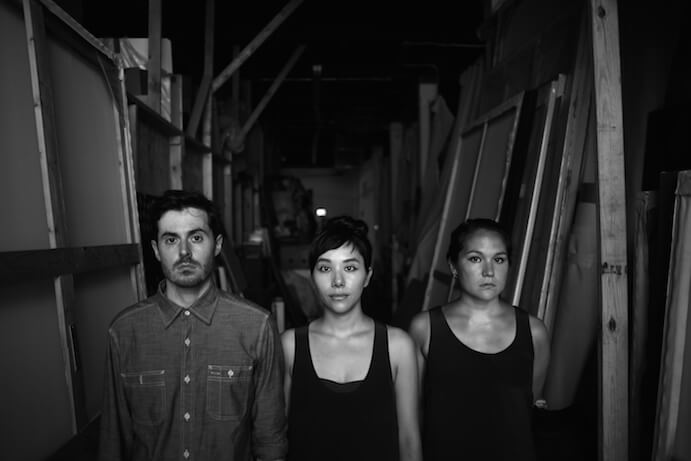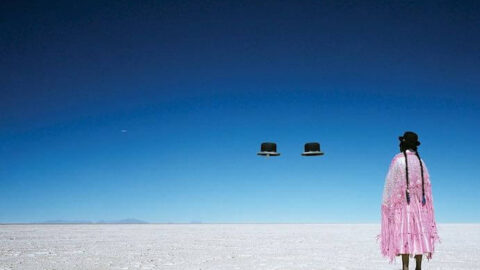With their debut album Passage (New Focus Recordings, 2017), the members of the string trio Longleash have cemented their reputation as a traditional ensemble with a contemporary voice. By focusing on recent repertoire, Pala Garcia (violin), John Popham (cello), and Renate Rohlfing (piano), are out to change the string trio’s musical world.
The five pieces that Longleash presents on Passage use no prepared piano or computer software. This acoustic-only setup provides an excellent context for the otherwise-limitless nature of the works they present. Each of the five featured composers focuses on exploring a different facet of music in their contributions, and each asks fundamental questions of the ensemble: “When does a tone begin?” “What is music and not noise?” “What kinds of sounds are possible, and how can they be made?” Questions like these define any repertoire that breaks with tradition.
The two movements of Christopher Trapani‘s Passing Through, Staying Put reflect the composer’s interests in Turkish music and in motion and stasis as musical devices. Both movements eschew any kind of steady pulse, but focus on the interplay between the voices. “Passing Through” has much more motion, which it achieves through string glissandi that pass between the violin and the cello. The piano plays mostly accompaniment, though occasionally comes to the front. The speed of the short glissandi followed by fast pizzicato passages creates tension that propels the music forward. Trapani’s experience with Turkish and Ottoman music (he studied in Istanbul on Fulbright scholarship) becomes even more obvious in “Staying Put.” Some of the string passages are written to imitate Middle Eastern plucked string instruments. Because this movement explores musical stasis, the composer uses repeated tones to create tension without musical motion. The glissandi in “Staying Put” are much longer and have more staggered entrances, creating more exposed textures. The repeated tones (or intervals, in the case of the piano) function like drones while minimizing some of the natural decay in the sound.

Clara Iannotta‘s compositions focus on the “choreography of sound,” evident in her four-movement trio Il colore dell’ombra. While none of the individual movements keep one steady pulse throughout, Iannotta’s writing relies on rhythmic drive in individual sections more than any of Longleash’s selections. This provides a much-needed contrast to the previous music. Her trio features the strings more than the piano, which plays open intervals spread across several registers. The third movement “Onirico” is the only slow movement, and by far the most evocative. It explores many of the same tone possibilities as Trapani’s “Staying Put” and later Filidei’s Corde Vuote. The short fourth movement brings the sounds and rhythms Iannotta has explored in the first three movements together into an electric finale that is over almost as soon as it begins. My only personal disappointment in the entire album was that the final movement wasn’t longer. Iannotta proves with it that she can write concise, direct music that is perfectly balanced and cohesive, and as with an incredible dessert, I wanted more.
Yukiko Watanabe has chosen the largest musical canvas of the five composers on the album. At over seventeen minutes, ver_flies_sen is an Ansel Adams-scale panorama of the experimental dialect she has created for this ensemble. Over the course of the piece, she performs a comprehensive sound and texture study, favoring harmonics and their breathy, ethereal quality. Watanabe relies on the dialogue between exposed solo lines and combined sounds to create the different textures. Her writing alternates between long sustained tones (without traditional vibrato) followed by sudden bursts of technical punctuation.

Strange Attractors by Juan de Dios Magdaleno is the most percussive selection, using low and repeated tones to imitate the sounds of percussion instruments. Of Passage’s five compositions, Strange Attractors also has the most acoustic space in it. The three voices are often written in registers far removed from each other, and there is more solo writing in the piece than there is combined instrumental texture. This can make it feel very angular, particularly during abrupt changes. Magdaleno’s conception of space in music and the scale of the space that he creates reveals architecture as a major musical influence.
The final composition on the album is Francesco Filidei‘s Corde Vuote, and is the most conventionally tonal (relatively speaking). Filidei’s compositional interests lie in the distinction between music and noise. In his own descriptions of his work, he has described it as “music which has lost its sound element.” Corde Vuote is made up of musical sounds (i.e., an instrument is creating sounds intentionally), but there is little connecting those sounds into larger ideas.
As a debut album, Passage is both ambitious and sincere. An ensemble like Longleash could easily spend its career playing only its standard classical repertoire: Haydn, Mendelssohn, Schubert, Brahms, and Schumann, perhaps adding Ives as a token eccentric, but Longleash shows no intention of doing so. The trio’s members have proven that they have a very different vision for their ensemble, and I look forward to hearing their next project.
























